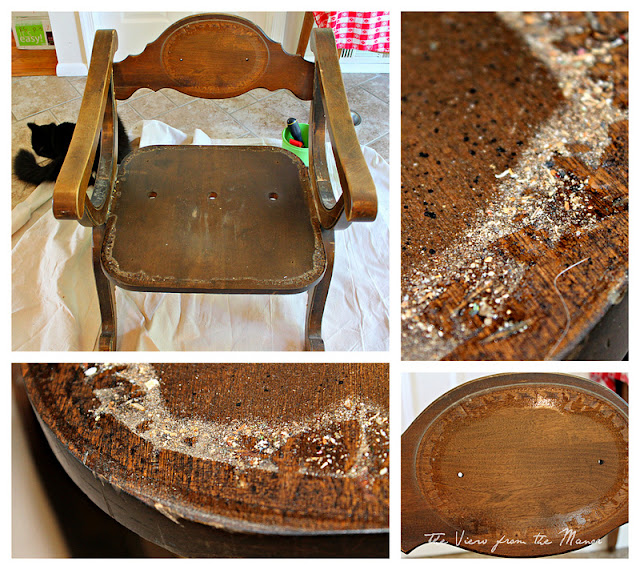Chirk Castle
This is the last castle we visited in Wales. Completed in 1310 it is the only Welsh castle from Edward I's reign that is still being lived in. Since it has been a residence for 700 years it shows evidence of renovations and upgrades from varying centuries. Since by this time I was getting pretty tired of climbing stairs I skipped the medieval tower and dungeon but I did see the 17th-century Long Gallery, grand 18th-century state apartments and servants' hall.
It is built around a large courtyard, which houses outdoor seating for the teashop. It was quite a warm, muggy day and it was a bit of a hike from the car park so the first thing we did was stop and get something cold to drink.
The 17th & 18th century apartments were lovely and had some unusual touches. The harpsichord was a beauty.
This was my favourite room. I wish I could have captured the colours correctly but I think the middle picture is the closest. The green was a celedon and the pink was the colour of the inside of a shell.
I'm really crushing on chandeliers right now.
These lovely young ladies were the daughters of the house in some bygone generation and their portraits flanked the fireplace at one end of the Long Gallery. I think they are late 17th/early 18th century and their decolletage would have been shocking a hundred years later. Apart from the lady at the top left (sorry she's a little out of focus) who I think is simpering too much, these sisters would be considered beauties even today.
I think this picture was of one of the King Georges as a child (who slept in the bed below when he was there) and his sister. I'm sorry it's so blurry but I had to take the picture without a flash in a particularly dark room. Aren't the colours gorgeous though?
The royal bedchamber - red and gold. And look at that red/black wallpaper! I wish I'd got a closeup of it.
And from the king's bedroom to the servants' hall. I love the leather fire buckets hanging from the beams, the long trestle tables and benches and the edifying inscription above the fire - "No noise, nor strife, nor swear at all but all be decent in the hall".
Plas Mawr
Plas Mawr is a gem of a Tudor town-house in the middle of Conwy. Built in the last quarter of the 16th century it has been restored to look much as it would have when it was built.
I loved this rough, studded oak door, with its snaky hinges.
One of the highlights of Plas Mawr was the plasterwork which has been restored and coloured to the brightness the Elizabethans would have demanded. This was the hall on the ground floor, originally the for the family, but when the new great hall was built upstairs this became the servants' hall.
The kitchens weren't particularly large but beautifully set out, with carved wood cupboards filled with pottery and utensils. As I may have mentioned at some point, I have a kitchenalia fetish.
You can see some traces of the wall paintings above the cupboard here.
The cook space was very well set out and equipped, with a small bread oven on the left, spits for roasting meats, a flat griddle for cooking over the coals and a cauldron.
More utensils, including some wicked looking skewers.

Next to the kitchen was the room where game was hung and prepared. It probably has its own name but I don't know what it is. [ETA - it's a larder, of course]
The trough below was used to salt the meat, and next to it is a very large mortar used to grind spices.
Upstairs was more restored plasterwork, left unpainted this time to highlight the craftsmanship.
All the modern conveniences.
My Lady's bedchamber, with Welsh textiles lining the (incredibly) ornate bed. Note the large bed-warming pan on the bench at the foot of the bed. Colder climate and no central heating...
On the way to Conwy is a woolen mill (more on that next time) that produces rugs and blankets very like this.
My Lady's chair, complete with warming footstool and seat cushion with the family coat of arms.
I had to get a closeup of the foot-warmer. The museum's attention to detail is amazing - you can just about make out the coal in the brazier, which would have sent heat up through the holes in the top to warm one's resting feet.
This was the Great Hall, with brightly painted plaster and sumptuous textiles. For all you DIY enthusiasts out there - that mantle is actually wood, painted to look like marble. The flooring is rugs over rush matting, over the wooden floor.

A closeup of the wall hangings.
Up more stairs and we came to the attic.
Originally this would have been the arched roof of the Great Hall but halfway through building it they realised it wouldn't work structurally so they put in a plastered ceiling in the Great Hall, and floored over to create an attic. Since the wooden arches wouldn't be seen they didn't bother to finish off the pegs holding it together so you can still see how it was all constructed.
Plas Mawr is an amazing place - I would highly recommend it to anyone visiting North Wales.
Next time (the last Wales post) - the woolen mill and a pilgrimage.
Wendy































































